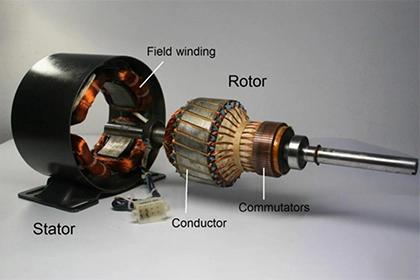
What is the difference between induction motor and synchronous motor?
The main difference between induction motors and synchronous motors is that induction motors rely on electromagnetic induction to create rotating magnetic fields while synchronous motors rely on a separate DC power source to create a magnetic field that rotates at a constant speed.
An induction motor and a synchronous motor are both types of electric motors that use electromagnetic induction to generate rotational motion. However, there are several key differences between these two types of motors that set them apart from one another.
One of the key differences between an induction motor and a synchronous motor is the way in which they generate rotational motion. An induction motor uses the magnetic field of the stator to induce a current in the rotor, which then creates a magnetic field of its own. This magnetic field interacts with the stator's magnetic field, causing the rotor to rotate and generate rotational motion.
In contrast, a synchronous motor uses the magnetic field of the stator to directly drive the rotor, causing it to rotate at the same speed as the stator's magnetic field. A synchronous motor uses a permanent magnet or an electromagnet to produce a magnetic field, and this magnetic field is used to directly drive the rotor.
Another key difference between an induction motor and a synchronous motor is the way in which they are controlled and operated. An induction motor is a type of asynchronous motor, which means that the speed of the rotor is slightly different from the speed of the stator's magnetic field. The difference between the synchronous speed of the stator's magnetic field and the actual speed of the rotor is known as the "slip," and it is a measure of the efficiency of the motor.
In contrast, a synchronous motor is a type of synchronous motor, which means that the speed of the rotor is the same as the speed of the stator's magnetic field. This allows a synchronous motor to operate at a constant speed, regardless of the load on the motor. However, this also means that a synchronous motor requires a precise and stable power supply in order to maintain its synchronous speed.
Another key difference between an induction motor and a synchronous motor is their efficiency and power output. An induction motor is typically more efficient than a synchronous motor, especially at low to medium speeds. This is because an induction motor can operate efficiently over a wide range of speeds and loads, and it does not require a precise and stable power supply to maintain its synchronous speed.
In contrast, a synchronous motor is typically less efficient than an induction motor, especially at high speeds. This is because a synchronous motor requires a precise and stable power supply in order to maintain its synchronous speed, and it can only operate efficiently at a specific speed and load.
In summary, an induction motor and a synchronous motor are both types of electric motors that use electromagnetic induction to generate rotational motion. However, there are several key differences between these two types of motors, including the way in which they generate rotational motion, the way in which they are controlled and operated, and their efficiency and power output.



Leave a Comment